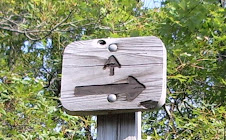
I’ve been reading books by some of the earlier hikers to get a sense of the Trail’s past and see how it has changed. I just finished “Walking with Spring,” which details the first-ever thru-hike of the Trail, done by Earl Shaffer in 1947. Amazing how fast he manages to do the distance, especially given the equipment he carries, including a backpack with no hipbelt. It’s also amazing how much the Trail and America have both changed. Strangers have no problem taking him in and feeding him. There’s still backwoods farmers living in Smokey Mountains and Shenandoah National Parks and the rangers there actually hike and maintain the park, instead of managing traffic and crowds as they do today. In the forests, American chestnut trees are everywhere, though they are in the process of succumbing to the blight that will make them virtually extinct today. Because of the War and a huge hurricane in the mid-40s, the Trail is so poorly maintained that Shaffer looses his way often, forcing him to bushwack and roadwalk large portions. Earl Shaffer was quite the hiker – he went back and did the Trail north to south in 1965, and then hiked it again for a third time in 1998 – at the age of 79!
The book I’m into now is Ed Garvey’s “Appalachian Trail, Adventure of a Lifetime.” Garvey thru-hiked in 1969 and wrote a book about the hike, his preparation, and detailed descriptions of the gear he used and food he ate. The first how-to for the Trail, it sparked a lot of interest in the Trail when it was published in 1971, and the number of thru-hikers started growing from a handful to hundreds in the 1980s. Garvey is great, a true hiker nerd. He’s got detailed directions on cooking mundane things like pasta, he picks up every piece of litter he finds (amazing how Americans had little problem littering back then), and he even pleads for hikers to wear nice button-up Boy Scout style hiking clothes to present a good image to the rest of the world. Of course, at the time the trail was still on a lot of private land where hiking privileges could be easily revoked, and the typical unshaven and smelly hiker might smack of “too much hippy” for the squares of the time. Garvey’s best moment comes when he makes camp and goes for water, but looses the path back to camp. Dark comes and he has to sleep on the ground and cover himself with leaves for warmth. After he makes it through the night, he finds his stuff, and gets off the trail for a well-deserved day off.
I also recently re-read Bill Bryson’s “A Walk in the Woods,” which is the book I would most recommend for novice Trail interest. Bryson is a travel and general interest writer, well known for his humor and his book is very popular. If you look at the stats on the numbers of thru-hikers, they peaked in the three years after his book came out, which suggests some correlation to me. The book tells of how Bryson attempts the trail, but he becomes frustrated with the various challenges, from dealing with Park Service bureaucracy to dealing with the other characters out hiking. Eventually, he becomes bored in Virginia, tired of looking at the unending “green tunnel” that can become tedious without milestones. This apparently happens to a lot of hikers in Virginia, where you are hiking for 500 miles without feeling any progress being made – the phenomenon is known as the “Virginia Blues”. One more thing to worry about.



No comments:
Post a Comment